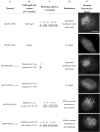Mutations in the C-terminal region affect subcellular localization of crucian carp herpesvirus (CaHV) GPCR
- PMID: 27059239
- PMCID: PMC4923094
- DOI: 10.1007/s11262-016-1325-y
Mutations in the C-terminal region affect subcellular localization of crucian carp herpesvirus (CaHV) GPCR
Abstract
G protein-coupled receptors (GPCRs) are known as seven transmembrane domain receptors and consequently can mediate diverse biological functions via regulation of their subcellular localization. Crucian carp herpesvirus (CaHV) was recently isolated from infected fish with acute gill hemorrhage. CaHV GPCR of 349 amino acids (aa) was identified based on amino acid identity. A series of variants with truncation/deletion/substitution mutation in the C-terminal (aa 315-349) were constructed and expressed in fathead minnow (FHM) cells. The roles of three key C-terminal regions in subcellular localization of CaHV GPCR were determined. Lysine-315 (K-315) directed the aggregation of the protein preferentially at the nuclear side. Predicted N-myristoylation site (GGGWTR, aa 335-340) was responsible for punctate distribution in periplasm or throughout the cytoplasm. Predicted phosphorylation site (SSR, aa 327-329) and GGGWTR together determined the punctate distribution in cytoplasm. Detection of organelles localization by specific markers showed that the protein retaining K-315 colocalized with the Golgi apparatus. These experiments provided first evidence that different mutations of CaHV GPCR C-terminals have different affects on the subcellular localization of fish herpesvirus-encoded GPCRs. The study provided valuable information and new insights into the precise interactions between herpesvirus and fish cells, and could also provide useful targets for antiviral agents in aquaculture.
Keywords: C-terminal; Crucian carp herpesvirus (CaHV); G protein-coupled receptor (GPCR); N-myristoylation site; Subcellular localization.
Figures






Similar articles
-
Structural and Functional Diversity among Five RING Finger Proteins from Carassius Auratus Herpesvirus (CaHV).Viruses. 2021 Feb 7;13(2):254. doi: 10.3390/v13020254. Viruses. 2021. PMID: 33562288 Free PMC article.
-
Fish herpesvirus protein (CaHV-138L) can target to mitochondrial protein FoF1 ATPase.Virus Res. 2020 Jan 2;275:197754. doi: 10.1016/j.virusres.2019.197754. Epub 2019 Oct 14. Virus Res. 2020. PMID: 31622636
-
Complete genome sequence and architecture of crucian carp Carassius auratus herpesvirus (CaHV).Arch Virol. 2016 Dec;161(12):3577-3581. doi: 10.1007/s00705-016-3037-y. Epub 2016 Sep 3. Arch Virol. 2016. PMID: 27591780
-
Herpesvirus-encoded GPCRs: neglected players in inflammatory and proliferative diseases?Nat Rev Drug Discov. 2014 Feb;13(2):123-39. doi: 10.1038/nrd4189. Epub 2014 Jan 21. Nat Rev Drug Discov. 2014. PMID: 24445563 Review.
-
Hijacking GPCRs by viral pathogens and tumor.Biochem Pharmacol. 2016 Aug 15;114:69-81. doi: 10.1016/j.bcp.2016.03.021. Epub 2016 Apr 6. Biochem Pharmacol. 2016. PMID: 27060663 Free PMC article. Review.
Cited by
-
Rana grylio virus 43R encodes an envelope protein involved in virus entry.Virus Genes. 2018 Dec;54(6):779-791. doi: 10.1007/s11262-018-1606-8. Epub 2018 Nov 8. Virus Genes. 2018. PMID: 30411182
-
Interaction between Two Iridovirus Core Proteins and Their Effects on Ranavirus (RGV) Replication in Cells from Different Species.Viruses. 2019 May 4;11(5):416. doi: 10.3390/v11050416. Viruses. 2019. PMID: 31060251 Free PMC article.
-
A transmembrane domain of Andrias davidianus ranavirus 13R is crucial for co-localization to endoplasmic reticulum and viromatrix.3 Biotech. 2019 Nov;9(11):433. doi: 10.1007/s13205-019-1961-8. Epub 2019 Nov 1. 3 Biotech. 2019. PMID: 31696038 Free PMC article.
-
Low-Cost and Rapid Method of DNA Extraction from Scaled Fish Blood and Skin Mucus.Viruses. 2022 Apr 18;14(4):840. doi: 10.3390/v14040840. Viruses. 2022. PMID: 35458570 Free PMC article.
-
Structural and Functional Diversity among Five RING Finger Proteins from Carassius Auratus Herpesvirus (CaHV).Viruses. 2021 Feb 7;13(2):254. doi: 10.3390/v13020254. Viruses. 2021. PMID: 33562288 Free PMC article.
References
MeSH terms
Substances
LinkOut - more resources
Full Text Sources
Other Literature Sources
Research Materials

